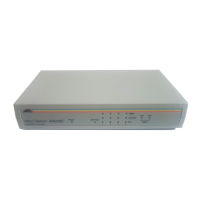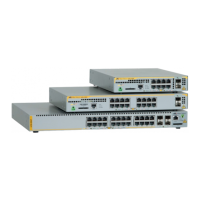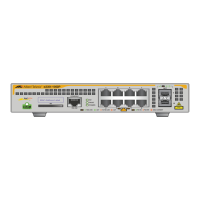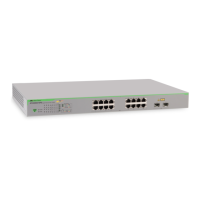Configuring Spanning Tree
Configuring Multiple Spanning Tree
Page 99
– Disable — Disables the port for the specific instance.
• Type — Indicates whether the port is a Boundary or Master port. The possible field values are:
– Boundary Port — Indicates that the port is a Boundary port. A Boundary port attaches MST bridges to
LANs in an outlying region. If the port is a Boundary port, this field also indicates whether the device on
the other side of the link is working in RSTP or STP mode.
– Master Port — Indicates the port is a master port. A Master port provides connectivity from an MSTP
region to the outlying CIST root.
• Role — Indicates the port role assigned by the STP algorithm to provide to STP paths. The possible field
values are:
– Root — Provides the lowest cost path to forward packets to the root device.
– Designated — Indicates the port or LAG through which the designated device is attached to the LAN.
– Alternate — Provides an alternate path to the root device from the root interface.
– Backup — Provides a backup path to the designated port path toward the Spanning Tree leaves. Backup
ports occur only when two ports are connected in a loop by a point-to-point link or when a LAN has two or
more connections to a shared segment.
– Disabled — Indicates the port is not participating in the Spanning Tree.
• Mode — Indicates the STP mode by which STP is enabled on the device. The possible field values are:
– Classic STP — Classic STP is enabled on the device. This is the default value.
– Rapid STP — Rapid STP is enabled on the device.
– Multiple STP — Multiple STP is enabled on the device.
• Designated Bridge ID — Displays the ID of the bridge that connects the link or shared LAN to the root.
• Designated Port ID — Displays the ID of the port on the designated bridge that connects the link or the
shared LAN to the root.
• Designated Cost — Indicates that the default path cost is assigned according to the method selected on the
Spanning Tree Global Settings.
• Forward Transitions — Indicates the number of times the LAG State has changed from a Forwarding state
to a Blocking state.
• Remain Hops — Indicates the hops remaining to the next destination.
3. Define the fields.
4. Click Apply. MSTP is defined for the selected interface, and the device is updated. The MSTP Page is
displayed.
5. Click Save Config on the menu, to save changes permanently.

